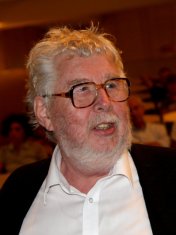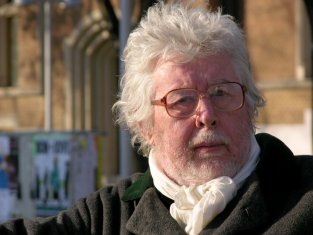|
|
Harrison Birtwistle (Composer, Arranger) |
|
Born: July 15, 1934 - Accrington, Lancashire, England |
|
Life |
|
The English composer, Harrison Birtwistle, was encouraged to be involved in music by his mother, who bought him a clarinet when he was seven, and arranged for him to have lessons with the local bandmaster. He became proficient enough to play in the local military-style band, and also played in the orchestra that accompanied Gilbert and Sullivan productions and the local choral society's performances of Messiah. He composed from around this time, later describing his early pieces as "sub Vaughan Williams".
In 1952 Harrison Birtwistle entered the Royal Manchester College of Music in Manchester on a clarinet scholarship. While there he came in contact with a talented group of contemporaries including Peter Maxwell Davies, Alexander Goehr, John Ogdon and Elgar Howarth. In 1965 a Harkness Fellowship gave him the opportunity to continue his studies at Princeton University, where he completed the opera Punch and Judy. This work, together with Verses for Ensembles and The Triumph of Time, established Birtwistle as an important voice in British music.
In 1975 Harrison Birtwistle became Musical Director of the newly established Royal National Theatre in London, a post he held until 1983. He has been honoured with a knighthood (1988) and as a Companion of Honour (2001). From 1994 to 2001 he was Henry Purcell Professor of Composition at King's College London. He was the 1987 recipient of the University of Louisville Grawemeyer Award for Music Composition. In 1995 he was awarded the Ernst von Siemens Music Prize. At the 2006 Ivor Novello Awards he criticised pop musicians at the event for performing too loudly and using too many clichés. |
|
Style |
|
It is not easy to link Harrison Birtwistle's music to any particular school or movement. For a time, he was described as belonging to the Manchester School, a phrase invented as a parallel to the Second Viennese School to refer to Birtwistle, Alexander Goehr and Peter Maxwell Davies. The phrase has since somewhat fallen out of use, since the three composers were united only by their early studies in Manchester, not by a common musical style. Birtwistle's music is complex, written in a modernistic manner with a clear, distinctive voice.
His early work is sometimes evocative of Igor Stravinsky and Olivier Messiaen (composers he has acknowledged as influences) and his technique of juxtaposing blocks of sound is sometimes compared to that of Edgard Varèse. His early pieces made frequent use of ostinati and often had a ritualistic feel. These have been toned down in recent decades as he has adapted and transformed the techniques into more subtle methods. With its strong emphasis on rhythm, the music is often described as brutal or violent, but this analysis mistakes the strong sound world for an attempt to evoke violent actions. The explicit violence of his first opera Punch and Judy - in which the murder of Judy by her husband is much more shocking when performed live on stage than by glove puppets in the classic British seaside entertainment - can easily be misinterpreted as a clue to the intention of his abstract music. The style is stark and uncompromising.
Harrison Birtwistle's favourite image for explaining how his pieces work is to compare them to taking a walk through a town - especially the sort of small town more common in continental Europe than Britain. Such a walk might start in the town square. Having explored its main features, we would set off down one of the side streets. As the walk continues, we might glimpse the town square down different streets, sometime a long way off, other times quite close. We may never return to the square in the rest of the walk or we may visit a new part of it that was not explored initially. Birtwistle suggests that this experience is akin to what he does in the music. His image conveys the way that a core musical idea is altered, varied and distorted as the piece of music progresses. The core music forms a reference point to which everything else is directed, even when we are walking in a completely different direction. Sometimes we will be less aware that it is the same musical material we are hearing; sometimes we may have been listening for a while before realising that we have heard this music before (just as one might have been looking up the street before realising that it is the town square that can be glimpsed through the traffic). He is not, therefore, suggesting that we imagine this walk through the town as a literal explanation of what is happening in the music; he does not 'recreate' the effect in the music (as Charles Ives does in some of his orchestral pieces).
An early variant of this technique involved literally cutting up the music, an example being Verses for Ensembles. Having composed a portion of music, Birtwistle would then cut it arbitrarily into a number of sections, which he then rearranged randomly. He would then add introductions, epilogues and music to link them together. This method was intended to give the whole piece unity, by having musical material with its own inner coherence scattered amongst musical material that still related to the core material but did not necessarily relate to itself.
Harrison Birtwistle's method of working is also reflected in the events of the first Act of his opera Gawain. Up to the point where the Green Knight is kneeling in front of Gawain awaiting the axe blow that will cut off his head, the action has proceeded mainly in chronological order. With Gawain holding the axe aloft, the stage is suddenly blacked out and, within a minute, the action has been rewound to the point preceding the Green Knight's entry to the Court of Arthur. Events are played through again, though compressed and with various small alterations, through the beheading and into the subsequent events. The events on stage are not randomly ordered, but the one event is portrayed from more than one perspective.
For the opera The Mask of Orpheus, this entailed two sets of singer/actors performing contradictory versions of the one event from the Orpheus myths. This non-linear portrayal of events on stage gives the listener a means of approach to the abstract compositions, with the same musical ideas being repeated but with extensive variation. The result is music that is often very episodic in structure. A clear example occurs in Silbury Air in which a readily identifiable musical motif – a blow from the tom-toms followed by scurrying figures from the strings and woodwind – is elaborated in a number of different ways as the piece progresses.
As a result, even when he is not writing a visual piece involving stage action, Birtwistle's music is frequently theatrical in conception. The music does not follow the logic and rules of classical forms such as sonata form, but is structured more like a drama. Furthermore, different musical instruments can almost be seen to take the part of different characters in the drama. This is especially apparent in a performance of Secret Theatre (1984). For various portions of the piece, a number of the instrumentalists perform in a 'soloist' capacity. For this, they leave their seat in the ensemble and stand separately, to one side of the ensemble, returning to the group when they are no longer given that role. Though not normally signaled by a change of position, this sort of changing role is constantly seen in his music. Related to this is the use of geological imagery to explain the structure of his 1986 orchestral piece Earth Dances. A number of different layers of musical material are present. At any one time, a layer might be to the fore, while at other times it might be buried deep beneath the other layers and no longer as apparent. |
|
Popular |
|
Though well established and widely respected in the classical music world Birtwistle was relatively unknown to the general public until the mid-1990's when two events brought him to the attention of a wider audience.
In 1994 two anti-modernist musicians, Frederick Stocken and Keith Burstein, calling themselves "The Hecklers," organised a demonstration at the first night of a revival of his opera Gawain at the Royal Opera House, London.
In 1995 Birtwistle's saxophone concertante work Panic was premièred in the second half of the Last Night of the Proms to an estimated worldwide television audience of 100 million. |
|
List of major works (Selection) |
|
See: List of compositions by Harrison Birtwistle |
|
Opera:
Punch and Judy (1967)
Down by the Greenwood Side, A Dramatic Pastoral, chamber opera (1968-1969)
Bow Down, chamber opera (1977)
Yan Tan Tethera, A Mechanical Pastoral, chamber opera (1986)
The Mask of Orpheus (1984), winner of the 1987 Grawemeyer Award in Music Composition.
Gawain (1990)
The Second Mrs Kong (1994)
The Last Supper (2000)
The Io Passion, chamber opera (2004)
The Minotaur (2008)
The Corridor, chamber opera (2009)
Other works:
Tragoedia, for flute, oboe, clarinet, bassoon, horn, harp and string quartet (1965)
Nomos, for orchestra (1968)
Verses for Ensembles (1968)
Down by the Greenwood Side (1969)
The Triumph of Time, for orchestra (1971-1972)
Grimethorpe Aria, for brass band (1973)
Silbury Air, for chamber orchestra (1976-1977)
...agm... (1978)
Secret Theatre, for chamber ensemble (1984)
Earth Dances, for orchestra (1986)
Endless Parade, for trumpet, vibraphone and strings (1986)
Antiphonies, for piano & orchestra (1992)
Panic, for alto saxophone, jazz drum kit & orchestra (1995)
Pulse Shadows (9 Movements for string quartet interleaved with 9 Settings of Celan) (1989-1996)
The Axe Manual, for piano & percussion (2000)
Theseus Game, for large ensemble with two conductors (2002)
Angel Fighter, dramatic cantata (2010)
String Quartet: Tree of Strings (2007)
Concerto for Violin and Orchestra (2009-2010)
In Broken Images, for ensemble (after the antiphonal music of Gabrieli) (2011)
The Moth Requiem, for 12 female voices, three harps & flute (2012)
Songs from the Same Earth, for tenor & piano (2012-2013)
Responses, piano concerto (2013-2014) |
|


|
|
Source: Wikipedia Website (January 2015); Photo 01: MITO SettembreMusica; Photo 02: © Universal Edition / Eric Marinitsch
Contributed by Aryeh Oron (May 2015) |
|
Harrison Birtwistle : Short Biography | Arrangements/Transcriptions: Works | Recordings |
|
Links to other Sites |
|
Harrison Birtwistle - Composer (Rayfield Allied)
Harrison Birtwistle - Biography (Bossey & Hawkes) [English/German]
Sir Harrison Birtwisle - Biography (Universal Edition) |
Harrison Birtwistle (Wikipedia)
Harrison Birtwistle - Biography (NMC Recordings)
Sir Harrison Birtwistle - Biographie (IRCAM) [French] |
|
Bibliography |
| |
|
|